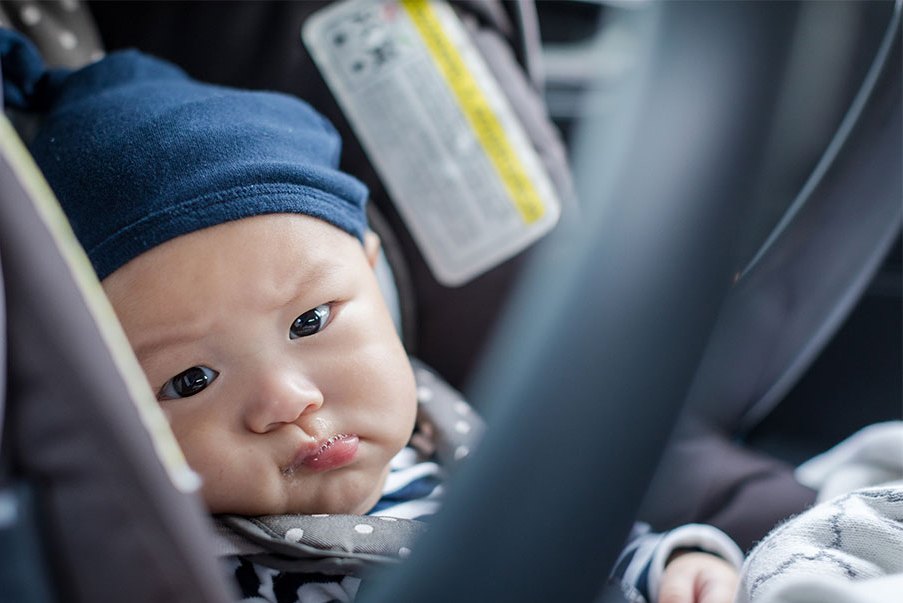The Dangers of Wearing Winter Coats in Car Seats

The risks outweigh the possibility your child will be too cold.
Experts: Dahlia Rizk, CPST; Sarah Tilton CPST
When it comes to baby safety, the proper use of a car seat is paramount. While designed and rigorously tested to protect your child in the event of a crash, the car seat is only as good as the person performing the installation and subsequent buckle-ups before driving; the security and efficiency of the car seat depend largely on parents’ knowledge of car seat safety and the judgment to make sound decisions for their children. The pressure may feel heavy, but the consequences can be life or death.
One predicament caregivers are faced with every year is how to keep a child warm while driving in cold weather. Dressing your baby for the elements may be your first defense, but it’s crucial to understand that winter coats are not safe for use in a car seat. Period. No matter the age or size of your baby, or the position of their car seat (rear-facing versus forward-facing), a winter coat presents a dangerous situation for your child when using a harness.
Although this understanding is the most important takeaway, we found that we still had other burning questions when it comes to winter coats and car seat safety: What is considered a winter coat? And is it OK to allow an older child in a booster seat to buckle up with the same outerwear? And how can I keep my baby comfortable, warm, and safe while in a vehicle? To answer these pressing queries, we connected with two child passenger safety technicians for all the important—and life-saving—details.
Everyday Car Seat Safety Recommendations
For winter car seat safety, the best place to start is by ensuring that your child’s car seat is used properly year-round. Even if you feel confident in your car seat set-up, it’s a good idea to periodically brush up on the basics and ensure you have the most up-to-date product information and current safety recommendations.
It’s also important to note that your vehicle, as well as your child’s age, weight, and height, will dictate what is considered a safe installation. For an in-depth look at the requirements for your specific car seat, experts say you’ll want to check your glove compartment.
“The safest car seat is not the most expensive but the one parents use correctly every trip,” says Dahlia Rizk, a child passenger safety technician in Boston, Massachusetts. “To make sure parents are using the seat correctly, they should read their car seat’s owner manual and their car’s owner manual.”
This is because not every car seat fits every car, explains Sarah Tilton, the director of consumer advocacy and child passenger safety technician for Britax. For example, if your car model is older than 2003, it may come with something other than the lower anchors used in the LATCH (Lower Anchors and Tethers for Children) installation needed to safely secure certain car seats. And even if your vehicle is newer, not every side or middle seat comes with the same anchor points. This can be problematic if you need to secure baby’s car seat in a certain spot for space, but that seat lacks the required hardware for installation. Because of this, Tilton says parents should consider the fit, position, and ease of installation when choosing a car seat.
In addition to your car seat and vehicle manuals, the National Highway Traffic Safety Administration instructs parents to follow these general guidelines:
- Place your child in the car seat with the child’s back flat against the car seat.
- Place harness straps over the child’s shoulders. Harness straps should lie flat, not twisted, and be placed through the slots located at or below your child’s shoulders.
- Buckle the harness and the chest clip, and tighten until snug. The harness should be snug enough that you cannot pinch any extra material at the shoulder. (Note that while a tight harness is crucial, it’s also important to ensure you’re not restricting blood flow or impacting circulation. If your child has deep red marks from the harness, you may be overtightening.)
- Place the chest clip at the armpit level. This holds the harness straps in place on the child’s chest and shoulders.
Consistency is key with car seats, even in cold weather, and here’s why.
The Risk of Winter Coats in Car Seats
As mentioned above, a child’s car seat harness is meant to lie flat and fit tightly across the chest for optimal safety, but the thick fabrics typically used in winter outerwear interfere with that process.
“A winter coat can compromise the safety of the car seat by providing a false sense that the 5-point [safety] harness is tight enough on the child riding in the seat,” explains Tilton. Well-intentioned parents may have an inaccurate perception that because the straps are snug their little one is also secure, which is not always the case.
“The puffiness of traditional winter coats bunches up behind the shoulders and under the harness of the car seat,” says Rizk. “In a crash, that bunched-up fabric will compress due to the force, creating 2 to 4 inches of slack under the harness [which in turn] creates extra forward movement. Research has found an increased likelihood of critical brain, neck, and spine injury at 6 millimeters of extra forward movement.” This excess slack can also cause a child to slip through the straps and be thrown from the seat.
Despite the potential risks and efforts made by the American Academy of Pediatrics (AAP) and other experts to educate the public on this danger, a 2019 study by Volvo found that approximately 65% of parents do not remove their child’s coat before putting them in a car seat. It’s also eye-opening that this safety measure is meant to be enforced with children even after they have outgrown their car seats, according to Rizk, acknowledging that while it’s the most critical for children in car seats, this ideal seating arrangement includes boosters and regular seat belts, too.
“Children of all ages as well as adults should not be wearing coats in the car as the puffiness of the coat interferes with the car seat harness and seat belt. Children under 6 years of age are more susceptible to injury as their bones are not fully hardened yet, so the warnings are usually applied more heavily to them.”
Considering the longevity of this precaution (and the fact that cold weather is also a concern), it’s fair for parents to wonder what can be worn while in a car seat, or how they can determine whether or not their child’s outerwear is a threat.
While Tilton specifies that Britax does not make recommendations on types of jackets and coats, she does encourage caregivers to perform a “pinch test” to determine if their child’s harness is tight enough.
“You should not be able to pinch any excess harness webbing at the child’s collarbone when they’re secured in the seat,” Tilton says. “If they are wearing thick clothing or a coat during the pinch test, we recommend a second step to this process: Remove the child from the car seat without loosening the harness system. Then remove the child’s coat and secure them back into their car seat without adjusting (loosening/tightening) the harness. Repeat the pinch test.”
She goes on to say if you can pinch any excess harness webbing using your thumb and pointer finger at the child’s collarbone level, your child’s coat (or jacket, thick sweater, vest, etc.) is not safe.
Tips for Keeping Baby Warm
While removing your child’s coat before buckling up will keep them safer, it certainly won’t keep them warm. And if you live in an area with frigid temperatures, you’ll need a strategy while waiting for the car heater to provide relief. Before your next outing, consider giving these tips a try.
- Put baby’s coat on backward: Once your little one is securely fastened in their car seat, put their hands and arms through the coat sleeves so that the back of the coat covers their chest and stomach over the buckled harness. They may not keep it on for the duration of the drive, but at least it offers the warmth of their winter coat without the risk. You can enlist the help of a blanket instead, or even use both.
- Use a Buckle Me Baby Coat: Created by Rizk, these coats were developed in collaboration with child passenger safety technicians, firemen, and first responders. The design opens along the side and shoulder seams, so caregivers can put the coat on before entering the vehicle and safely keep the coat on while in transit. According to Rizk, Buckle Me Baby Coats are CPST-approved and have been crash-tested at an independent university crash test facility where they “not only outperformed traditional puffy coats but also tested similarly to no coat at all.”
- Check if your car seat has approved accessories: Tilton notes that some baby gear manufacturers offer products to help with weather-related concerns, such as the Britax B-Warm Car Seat Cover, but she warns it’s important to make sure any potential accessory is compatible with your specific car seat.
Being informed about car seat safety—no matter the season—is an ongoing endeavor for every parent. If you have additional questions about installation, car seat use, or anything related to your child’s safety as a passenger, Rizk advises parents to book a visit with a local CPST. Additionally, Tilton notes that Britax offers virtual 1:1 appointments for car seat safety checks (any brand welcome!), as well as pinch test demonstrations, so all parents can have peace of mind while behind the wheel.








